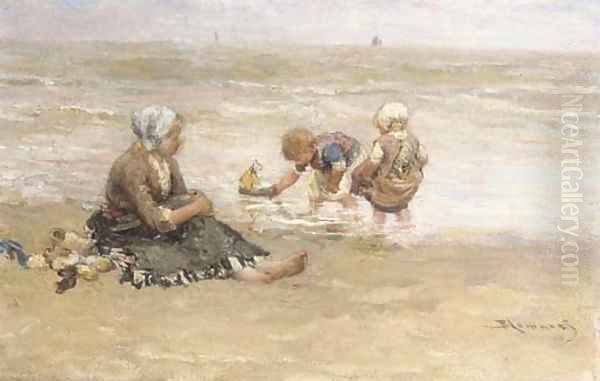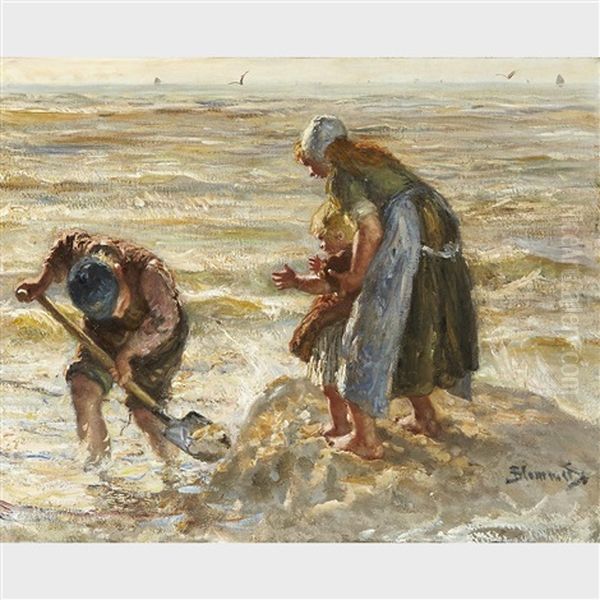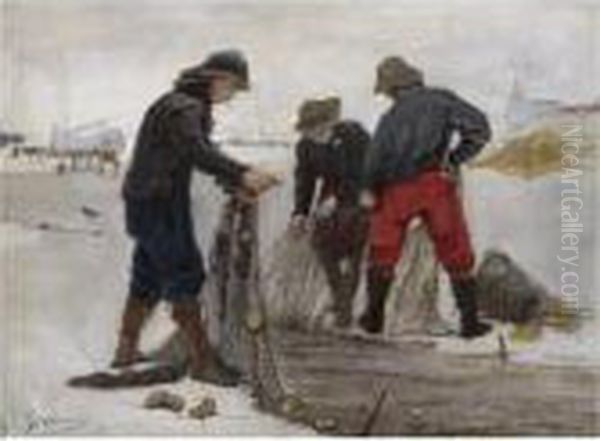
Bernardus Johannes Blommers stands as a significant figure within the rich tapestry of 19th-century Dutch art. Born in The Hague in 1845 and passing away in the same city in 1914, Blommers dedicated his artistic career to capturing the essence of Dutch life, particularly the coastal communities and the intimate moments of family existence. As a prominent member of the Hague School, he contributed a unique perspective, often focusing on the brighter, more harmonious aspects of everyday life, setting his work apart while remaining deeply rooted in the movement's realistic principles. His paintings, celebrated both domestically and internationally during his lifetime, continue to resonate with viewers for their warmth, sincerity, and technical skill.
Early Life and Artistic Beginnings
Bernardus Johannes Blommers entered the world in The Hague, a city that would remain central to his life and work. Growing up during a period of artistic transition in the Netherlands, where the romantic ideals of the preceding generation were gradually giving way to a more grounded realism, Blommers was well-placed to absorb the changing currents. While specific details of his earliest training can be elusive, it is highly probable that he received formal instruction at the Royal Academy of Art in The Hague, a common path for aspiring artists of his time.
His initial training likely included foundational skills such as drawing and perhaps lithography, which was a common starting point before specializing in painting. This early grounding would have provided him with the technical proficiency evident in the detailed rendering found in his earlier works. The artistic environment of The Hague in the mid-19th century was increasingly influenced by the desire to depict the local landscape and its inhabitants with honesty and authenticity, moving away from idealized or historical subjects. This burgeoning realism formed the backdrop against which Blommers would develop his own artistic voice.
The Hague School Context

Blommers emerged as an artist during the formative years of the Hague School, a movement that defined Dutch painting in the latter half of the 19th century. This group of artists shared a commitment to realism and a preference for depicting the landscapes, coastal scenes, and daily life of the Netherlands. They reacted against the polished academicism and romantic sentimentality that had previously dominated, seeking instead a more direct and truthful representation of their surroundings. Often characterized by their atmospheric depictions and tonal palettes, they were sometimes referred to as the "Grey School," although this label doesn't fully capture the diversity within the movement, especially concerning Blommers' later, brighter works.
Key figures associated with the Hague School include Jozef Israëls, often considered a leading figure, known for his poignant portrayals of peasant and fishing communities; Anton Mauve, celebrated for his landscapes with sheep and cattle; the three Maris brothers – Jacob (landscapes and townscapes), Willem (meadows and cattle), and Matthijs (dreamlike figures and scenes); Hendrik Willem Mesdag, famed for his dramatic seascapes, particularly the Panorama Mesdag; Johannes Bosboom, who specialized in church interiors; and pioneers like Willem Roelofs and Johan Hendrik Weissenbruch, masters of light and atmosphere in landscape painting. Paul Gabriël and Théophile de Bock also contributed significantly to the landscape genre within the school.
Within this esteemed group, Blommers carved out his own niche. While sharing the commitment to realism and Dutch themes, he distinguished himself by focusing predominantly on genre scenes, particularly those involving the fisherfolk of Scheveningen and Katwijk. His emphasis was often on the interior lives, the domestic sphere, and the moments of quiet joy and familial connection, offering a counterpoint to the more somber or rugged depictions of rural and coastal life presented by some of his contemporaries.
Subject Matter: The Poetry of Everyday Life
Blommers' choice of subject matter consistently revolved around the lives of ordinary Dutch people, finding beauty and significance in their daily routines and interactions. He was particularly drawn to the coastal villages near The Hague, immersing himself in their unique culture and environment.
Coastal Communities: Scheveningen and Katwijk

The fishing villages of Scheveningen and Katwijk provided Blommers with endless inspiration. These locations were popular subjects for many Hague School painters, offering dramatic coastlines, bustling harbours, and picturesque scenes of traditional life. Blommers, however, often turned his gaze inward, towards the community itself. He depicted the beaches not just as landscapes, but as stages for human activity – children playing in the sand, women mending nets or waiting for the fishing boats to return, families gathered near their homes. His work captures the specific atmosphere of these places, imbued with the salt air and the rhythms of life dictated by the sea. He even established a studio in Scheveningen, reportedly modeled after a traditional fisherman's cottage, allowing him to work in close proximity to his subjects and achieve a greater sense of authenticity.
The Fisherman's World: A Focus on Home
While the sea was an omnipresent backdrop, Blommers was less concerned with the perils of fishing itself, a theme often explored by Jozef Israëls, and more interested in the lives of the families ashore. His interiors depict mothers tending to children, preparing meals, sewing, or simply sharing quiet moments. These scenes are rendered with sensitivity and an eye for detail, capturing the textures of fabrics, the play of light within humble cottages, and the simple furnishings that defined these homes. Works like Het bereiden van de maaltijd (Preparing the Meal) exemplify this focus. He consciously chose to emphasize the "happiness and tranquility" of family life, presenting a view of the fishing community centered on resilience, affection, and domestic stability, rather than solely on hardship.
Childhood Innocence
Children feature prominently in Blommers' oeuvre. He depicted them with tenderness and understanding, capturing their uninhibited play on the beaches, their interactions with parents and siblings, and their quiet absorption in simple activities. Paintings such as Children Playing on the Beach or SPELENDE VISSERSKINDER (Playing Fisher Children) showcase his ability to portray the naturalism and charm of childhood. This focus aligns with a broader 19th-century interest in the theme of childhood, but Blommers grounds his depictions in careful observation, avoiding excessive sentimentality. His children are integral parts of the community, their presence adding life and warmth to his scenes. The work Where Are the Little Doves?, praised by critics for its emotional depth, likely falls into this category of intimate family scenes involving children.
Domestic Interiors and Light

Blommers demonstrated considerable skill in rendering interior spaces. He paid close attention to the effects of light filtering through windows, illuminating figures and objects within the home. This interest in light and interior space connects his work to the long tradition of Dutch Golden Age genre painting, recalling masters like Pieter de Hooch and Johannes Vermeer, who excelled at capturing domestic scenes with remarkable sensitivity to atmosphere and detail. Blommers adapted this tradition to his own time and subjects, creating interiors that feel both authentic and imbued with a sense of peaceful intimacy. His watercolor and gouache work, such as Mother and Child in the Interior, further showcases his versatility in handling different media to capture these quiet moments.
Artistic Style: From Realism to Radiant Light
Blommers' artistic style evolved throughout his career, though it remained fundamentally rooted in realism and careful observation. His development reflects both his personal artistic journey and the broader shifts occurring within Dutch art.
Early Precision and Detail
In his earlier works, Blommers displayed a meticulous approach characteristic of academic training and the initial phase of the Hague School's realism. He rendered details with great care, paying close attention to the textures of clothing, the specific features of interiors, and the accurate depiction of figures. This precision lent his scenes a strong sense of veracity and groundedness. His figures were solidly drawn, and compositions were carefully constructed to convey the narrative or mood effectively.
Developing Brushwork and Color Palette
As his career progressed, Blommers' technique became somewhat freer and more painterly. While never abandoning realism, his brushstrokes grew looser and more expressive, allowing for a greater sense of immediacy and atmosphere. This shift is particularly noticeable in his handling of light and outdoor scenes. Concurrently, his color palette, initially more subdued and tonal in line with the early Hague School aesthetic, began to brighten considerably. He incorporated more vibrant greens, blues, yellows, and oranges, especially in his beach scenes, capturing the effects of sunlight on sand, sea, and sky with increasing vibrancy. This evolution might reflect a subtle absorption of Impressionist ideas about light and color, though Blommers remained distinctly a Hague School painter in his overall approach and subject matter.
Mastery of Mediums
Blommers was proficient in both oil painting and works on paper, particularly watercolor and gouache. His oil paintings possess a richness and depth, allowing for complex layering and textural effects. His watercolors, often characterized by their luminosity and freshness, demonstrate his skill in capturing fleeting effects of light and atmosphere with a more delicate touch. Works like Mother and Child in the Interior highlight his ability to convey intimacy and subtle emotion through watercolor combined with gouache for opacity and body. This versatility allowed him to explore his chosen themes across different scales and levels of finish.
Significant Works: Capturing Moments
Several works stand out in Blommers' oeuvre, representing key aspects of his style and thematic concerns.
Where Are the Little Doves?
This painting, specifically mentioned in contemporary accounts for receiving high praise from critics, likely depicted an intimate domestic scene, possibly involving a mother and child engaging in a simple, tender moment suggested by the title. Its acclaim for "emotional depth and realism" points to Blommers' success in transcending mere representation to convey genuine human feeling. It exemplifies his focus on the positive, affectionate aspects of family life within the working communities he portrayed.
Preparing the Meal (Het bereiden van de maaltijd)
This recurring theme in Blommers' work captures the heart of his domestic focus. Typically depicting a mother or woman preparing food in a simple cottage interior, often with children nearby, these paintings celebrate the quiet rhythm of daily life. They highlight the centrality of the home and the role of women in maintaining the family unit. Blommers' skill in rendering light, texture, and the humble details of the setting imbues these scenes with warmth and dignity. The painting dated 1870-1914 in the Rijksmuseum collection is a prime example.
Children Playing on the Beach / Building Sandcastles
These titles represent a significant body of work focused on childhood by the sea. Blommers excelled at capturing the energy and absorption of children at play, set against the backdrop of the Scheveningen or Katwijk coast. The beach becomes a space of freedom and simple pleasures. Building Sandcastles, noted as having appeared at auction, typifies this popular theme, showcasing his brighter palette and looser brushwork in depicting sunlight and the open air, combined with affectionate observation of the children's activities.
Portrait of Andrew Carnegie (1913)
This later work marks a departure from Blommers' usual subject matter but connects to his Hague roots through its destination: the Peace Palace. Commissioned or donated for this international institution, the portrait depicts the philanthropist Andrew Carnegie, a major funder of the Peace Palace, within a library setting. Completed the year before Blommers' death, it reflects an engagement with broader societal themes of peace, international cooperation, and philanthropy, aligning with the ideals embodied by the Peace Palace itself. It also demonstrates his capability as a portraitist.
Other Notable Works
Other representative works further illustrate his range and consistency, including Milkmaid (c. 1914), showing his continued interest in rural labor; Fishermen at Scheveningen Beach, capturing the working aspect of the coast; and Green-Clothed Little Girl (c. 1895), a charming example of his portraiture focusing on children. Each piece contributes to the overall picture of an artist deeply engaged with the human dimension of the Dutch landscape and coastal life.
Studio Life, Observation, and Relationships
Blommers' working methods were grounded in direct observation, a hallmark of the Hague School. His decision to establish a studio in Scheveningen, designed like a fisherman's cottage, underscores his commitment to authenticity and his desire to be close to the lives he depicted. This proximity allowed him to capture nuances of gesture, expression, and environment with greater accuracy and empathy.
His relationship with Jozef Israëls was significant. Blommers acknowledged learning from the elder master, particularly regarding the observation and depiction of human expression. However, he consciously diverged from Israëls's often somber portrayal of the hardships faced by fishing and peasant communities. Blommers chose instead to highlight the resilience, affection, and quiet joys within these same communities, offering a complementary, more optimistic perspective. This difference defines Blommers' unique contribution within the broader Hague School narrative.
A key personal and professional connection was with Jan Zoetelief Tromp (1872-1947). Tromp was not only a student of Blommers but also became his son-in-law, marrying Blommers' daughter. As an artist, Tromp continued in a similar vein, becoming known for his cheerful scenes of children playing, often bathed in bright sunlight, arguably taking Blommers' inclination towards optimism even further. This familial and artistic lineage extended Blommers' influence into the next generation.
Blommers worked alongside and interacted with the other major figures of the Hague School, contributing to the vibrant artistic milieu of The Hague. His focus on genre scenes complemented the landscape work of Mauve, Weissenbruch, Roelofs, and the Maris brothers, and the seascapes of Mesdag. While distinct, his work shared the underlying principles of realism and atmospheric sensitivity that united the movement. The broader context of European Realism, including the French Barbizon School painters like Jean-François Millet, who championed depictions of rural life, undoubtedly provided a backdrop for the Hague School's development. Even Vincent van Gogh, in his early years, expressed admiration for Hague School artists, including Mauve (his cousin-in-law) and Israëls, indicating the movement's significance.
Reception and Enduring Legacy
During his lifetime, Bernardus Johannes Blommers enjoyed considerable success and recognition. His paintings were popular not only in the Netherlands but also found eager audiences abroad, particularly in the United Kingdom, the United States, Canada, Australia, and South Africa. His appealing subject matter, combined with his technical skill and the perceived authenticity of his depictions of Dutch life, resonated with international collectors and audiences.
His reputation was solidified by accolades such as the Grand Gold Medal awarded to him in The Hague in 1900. His works were acquired by major museums, and continue to be held in important public collections, including the Rijksmuseum in Amsterdam and the Kunstmuseum Den Haag (formerly Gemeentemuseum). His paintings remain sought after on the art market today.
Blommers' legacy lies in his contribution to the Hague School and his sensitive portrayal of Dutch domestic and coastal life. He offered a vision centered on harmony, family, and the quiet dignity of ordinary people. While acknowledging the influence of figures like Israëls, he forged his own path, emphasizing warmth and light where others might have focused on shadow and struggle. His influence extended through his students, most notably his son-in-law Jan Zoetelief Tromp, ensuring that his particular vision of idyllic genre scenes continued into the early 20th century.
Conclusion
Bernardus Johannes Blommers remains an important and appealing figure in Dutch art history. As a core member of the Hague School, he shared its commitment to realism and the depiction of contemporary Dutch life. Yet, he distinguished himself through his consistent focus on the intimate world of families, particularly those in the coastal villages of Scheveningen and Katwijk. His paintings, characterized by careful observation, evolving technique, and a prevailing sense of warmth and tranquility, celebrate the simple routines, familial bonds, and innocent joys of everyday existence. Avoiding overt sentimentality while also choosing not to dwell on hardship, Blommers crafted a body of work that offers a gentle, humane, and enduring vision of life in the Netherlands during the late 19th century. His art continues to provide insight into the era and delight viewers with its sincerity and quiet beauty.